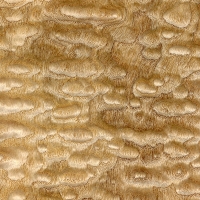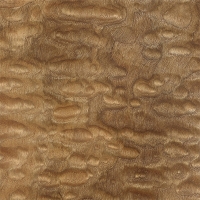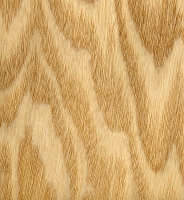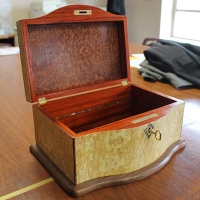 |
Common Name(s): Tamo Ash, Japanese Ash, Manchurian Ash Scientific Name: Fraxinus mandshurica (sometimes spelled mandschurica) Distribution: Northern Asia (China, Korea, Japan, and Russia) Tree Size: 65-100 ft (20-30 m) tall, 1-2 ft (.3-.6 m) trunk diameter Average Dried Weight: 35 lbs/ft3 (560 kg/m3) Specific Gravity (Basic, 12% MC): .50, .56 Janka Hardness: 1,010 lbf (4,490 N)* *Estimated hardness based on specific graivty Modulus of Rupture: 10,810 lbf/in2 (74.6 MPa) Elastic Modulus: 1,195,000 lbf/in2 (8.24 GPa) Crushing Strength: No data available Shrinkage: No data available |
Color/Appearance: The heartwood is a light to medium brown color. Sapwood can be very wide, and tends to be a beige or light brown; not always clearly or sharply demarcated from heartwood. Deeply figured grain patterns are possible, sometimes called “peanut” figure, so called because the rotary-sliced veneer has an almost three-dimensional patterning that looks like peanut shells.
Grain/Texture: Grain is generally straight, though portions with wild/figured grain are commonly sold. With a coarse uneven texture.
Rot Resistance: Heartwood is rated as perishable; poor insect/borer resistance.
Workability: Produces good results with hand or machine tools. Glues, stains, and finishes well.
Odor: Gives off a distinct, moderately unpleasant smell when being worked.
Allergies/Toxicity: Ash in the Fraxinus genus has been reported to cause skin irritation, and a decrease in lung function. See the articles Wood Allergies and Toxicity and Wood Dust Safety for more information.
Pricing/Availability: Sold almost exclusively as veneer, and nearly always with figured grain of some sort. Reportedly quite rare, and in limited supply; most veneer is exported from Japan. Prices are high for an imported veneer and are linked to the degree of figure in the grain: higher figure means higher prices.
Sustainability: This wood species is in CITES Appendix III, but is not on the IUCN Red List of Threatened Species.
Common Uses: Veneer, musical instruments (drum shells and guitars), fine furniture, marquetry, and other small speciality wood items.
Comments: Tamo Ash has a grain pattern and figure that is completely unique (the closest in appearance may be Quilted Maple). In its plain, unfigured form, Tamo Ash is very similar to the North American species Black Ash (Fraxinus nigra), and is usually simply referred to as Japanese Ash (with the name Tamo being reserved for the more figured sections of wood).
It is anecdotally reported that the peanut figure found in higher grades of Tamo Ash are caused by vines which wrap themselves around the tree’s trunk, restricting the flow of nutrients and causing the tree to grow in an uneven stop-and-go manner. Allegedly, propagators in Japan grew trees and tied ropes around the younger trees—successfully duplicating the peanut figure as the trees reached maturity.
When stained, ash can look very similar to oak (Quercus spp.), although oaks have much wider rays, which are visible on all wood surfaces—even on flatsawn surfaces, where they appear as short, thin brown lines between the growth rings. Ashes lack these conspicuous rays.
Scans/Pictures: A special thanks to Dan Pape for contributing a veneer scan of the unfigured wood.









Eric Meier and (please pass this on to) Dave Pape, Guys, thank you SO much for doing all the things you did to bring this website, pix and info to me at just the right time in my life! I bought an ‘interesting looking’ item from a FB Marketplace Seller for $10. Once I started researching it, it began to produce more questions with each answer…one of those kinds of things. ANYWHOOOO, when it got to the chunk of wood this thing is painted on, I thought maybe it’s some bizarre bamboo or Sago or??? I sent pix… Read more »